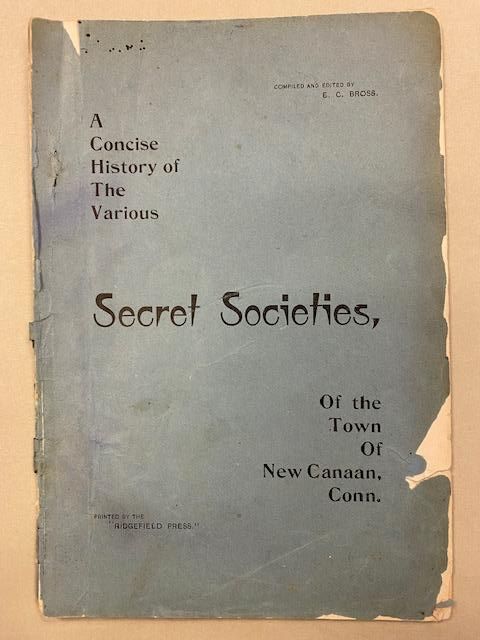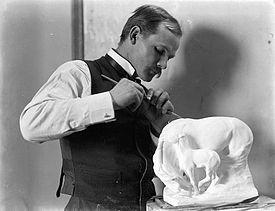
New Canaan’s Secret Societies

There are times when I wish I could squirrel myself away in the vault of the New Canaan Museum & Historical Society and spend weeks exploring all that it contains. A popcorn bucket painted by Silvermine artist D. Putnam Brinley, Frieda Stege’s landscape design sketches, Eliot Noyes’ architectural model of a ski lodge in Aspen, Arthur Szyk’s colorful anti-fascist illustrations are mixed in with documents, records, paintings, photographs, and ephemera, including swords, baskets, bottles, and even a full silver tea service. Cold and isolated, sealed behind a heavy door with a combination lock, the vault contains not only many of the most treasured objects from New Canaan’s history, but its mysteries and secrets, too.
So it was fitting that this week I discovered a small pamphlet entitled “A Concise History of the Various Secret Societies of the Town of New Canaan, Connecticut” – Document #732 in the Museum’s archives – that was edited by E. C. Bross and printed by the Ridgefield Press. We had no information on Bross, or the date of the book’s publication. Through a search of Newsbank’s digital historic newspapers, I learned that Edgar C. Bross was born in New Castle, Delaware, was at one time the editor of the New Amstel Magazine of Wilmington, Delaware, and married Anna M. Benedict, the daughter of Caroline S. Benedict of New Canaan sometime before 1896. At least by 1899, it appears they had moved to Ridgefield and were both members of the Sunshine Society Corner of the Connecticut T.S.S. Ridgefield Branch, but by 1916, they had moved to Boston. (I called my best source for New Canaan history, Don Hersam, former publisher and editor of the New Canaan Advertiser, but even he knew nothing of Bross, the Sunshine Society, the Connecticut T.S.S., or the secret society publication.)
According to the Publisher’s Note, the purpose of of the book was “to give to the members of the various secret fraternities of the picturesque town of New Canaan, a complete, though concise, history of those organizations which have done so much to relieve the widow and orphan; to nurse the sick and to bury the dead.” It then elaborates on the following:
Wooster Lodge, No. 37, Independent Order of Odd Fellows: As described by Bross, “[A] member practically banks his money with the lodge on a purely business basis, with the promise of dividends at irregular periods, instead of definite dates as in a Savings Bank.” The Lodge provided nursing care for ill members and the “brothers” had a “duty to visit and cheer the sick.” As of print date, the membership numbered 150, and the Chaplain was Francis E. Weed.
Friendship Division, No. 10, Sons of Temperance: This group apparently focused on “various sociables.” The idea, according to Bross, was that “members become interested in literary matters and music and with this taste, once acquired, they can discover no congenial attractions in the guilded saloon – that deadly enemy to noble mankind.” Founded in 1845, it admitted women members in 1870. The Hoyt family – Edwin, James, and the Reverend J. Howard – were all members.
Weiland Lodge, No. 20, Sons of Hermann: Founded to perpetuate the legacy of Hermann, described as a German “patriot, heroic and grand,” its principles were Charity, Liberty, Benevolence, and Good-will to fellow men. The New Canaan chapter started in 1890 and was known for its generous investment in a profitable business of $500 per ill member so that the proceeds could support that person’s family.
Samuel P. Ferris Post, No. 61, Grand Army Post: Established on February 6, 1883, this society’s members fought in “many battles, from that of the first Bull Run to Appomattox, and covering the territory of Gettysburg to the Rio Grande.”
Commodore Perry Council, No. 44, Order of United American Mechanics: This society, founded November 22, 1889, was a patriotic organization promoting love of the flag and American institutions at a time “when anarchistic and communistic doctrine – a disease resultant from the strained social conditions of the Old World – infects the American republic to an alarming extent.”
Oenoke Tent, No. 8, Knights of the Maccabees: This 1893 society offered a liberal insurance as an inducement to join. A “tabular statement” indicates that, if a member was between the age of 40 and 45, he could pay $.75 a month in assessments to receive $1000 in life/disability insurance.
And then, of course, there were the Masons, Harmony Lodge, No. 67, who met upstairs in the original Town Hall (what is not the Susan Bishop Gallery of the New Canaan Museum & Historical Society.) It urged its members to “control their passions; practice charity; to act squarely with all mankind; to refrain from all calumnious gossip which might lead to the ruin of innocent lives; and to pay homage to Deity which at once constitutes duty and happiness.”
A big thanks to Edgar Bross for making New Canaan’s secret societies not so secret. Warmly, Nancy GearyExecutive Director
Warmly,
Nancy Geary
Executive Director




